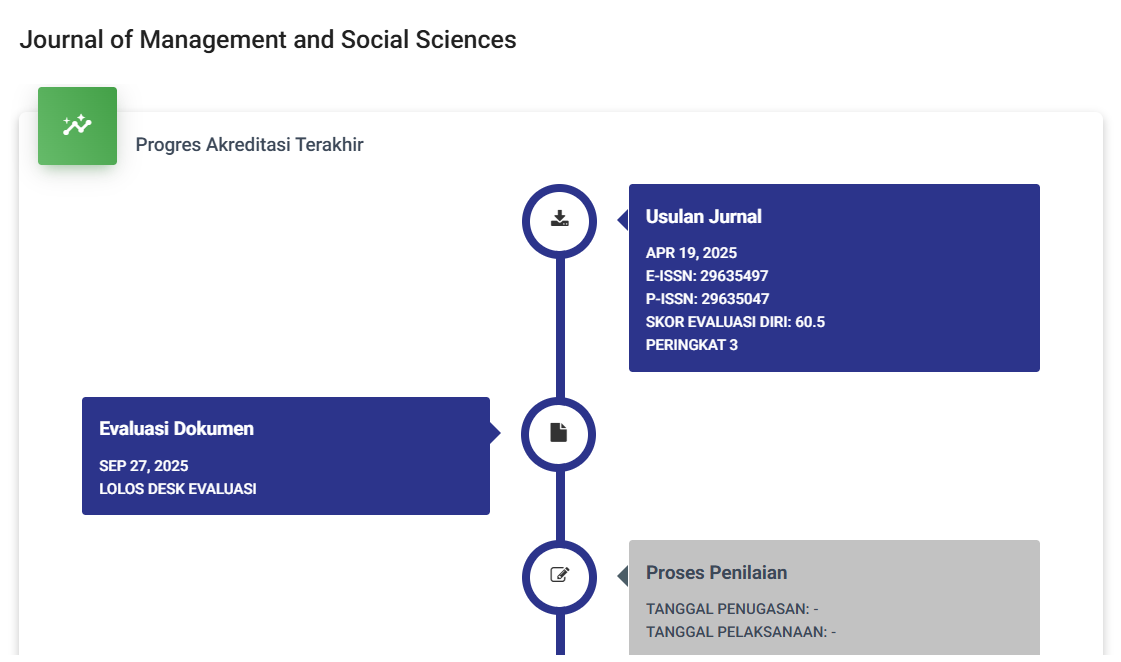Efektivitas Penerapan Absensi Elektronik Dalam Meningkatkan Disiplin ASN Di Kantor Kecamatan Batuputih Kabupaten Kolaka Utara Provinsi Sulawesi Tenggara
DOI:
https://doi.org/10.55606/jimas.v1i2.254Keywords:
Discipline, Bureaucracy, Employees.Abstract
This study aims to see the effect of the effectiveness of electronic attendance (finger print) on employee discipline, both in terms of attendance level, convenience and comfort in the attendance process and the application of electronic attendance (finger print) in making it easier for superiors to see employee discipline both in terms of attendance, as well as employee discipline. The results of the study show that the application of finger print attendance has increased employee work discipline, seen from the achievement of targets after the application of finger print attendance has been achieved, where it is known that there are still many employees who are disciplined at work such as arriving on time to the office. Adaptability, employees already understand the procedures regulations for using finger print attendance and being able to adjust from manual attendance to finger print attendance due to previous trials. Job satisfaction for employees is good because of additional employee income (TPP). While the responsibilities of the employees have progressed but not maximized, because there are still employees who leave the office after filling in absences for personal needs. has not increased, there are still many employees who come late to the office. This study discusses the effect of finger print absences on employee discipline. This research is motivated by the problem of the level of punctuality of employees when entering and leaving work, so that it becomes an interesting phenomenon to study. This type of research is qualitative research. Data collection techniques used in this study through interviews, observation, and documentation.
References
Buku :
B. Siswanto Sastrohadiwiryo, 2003. Manajemen Tenaga Kerja Indonesia, edisi 2,Jakarta, PT. Bumi Aksara.
Davis, B. Gordon, 2009. Kerangka Dasar Sistem Informasi Manajemen, PT.Midas Surya Grafindo. Jakarta.
Gibson, James L., Jhon M. Ivancecich., dkk. 1996. Organisasi Perilaku, Struktur dan Proses. Jakarta : Binapura Aksara.
Ghouzali Saydam, 2005. Manajemen Sumber Daya Manusia : Suatu Pendekatan Mikro. Jakarta : Djambatan.
Hasibuan, Melayu. 2002. Manajemen Sumber Daya Manusia : edisi revisi cetakan kelima, Jakarta : Bumi Aksara.
Tangkilisan (2005). Manajemen Publik. Jakarta: Gramedia Widyasaran.
Mahsun, Mohammad. 2006. Pengukuran Kinerja Sektor Publik. Yogyakarta : BPFE.
Mangkunegara, A P. 2001, Manajemen Sumber Daya Manusia Perusahaan. Bandung : PT Remaja Rosdakarya.
Moleong, Lexy J., 2016.Metedologi Penelitian Kualitatif, Ed. Revisi, Bandung : PT Remaja Rosdakarya.
Sinungan, Muchdarsyah. (2003). Produktivitas Apa dan Bagaimana. Bandung : Bumi Aksara Sedarmayanti. 2010. Manajemen Sumber Daya Manusia Reformasi Birokrasi dan Manajemen Pegawai Negeri Sipil.Bandung : PT. Refika Aditama.
Sondang P. Siagian, 2001, Manajemen Sumber Daya Manusia, Bumi Aksara, Jakarta.
Sugiyono. 2015. Metode Penelitian Kuantitatif, Kualitatif dan R&D. Bandung: Alfabeta.
Tangkilisan, Hassel Nogi S. 2005, Manajemen Publik. Jakarta : Grasindo.
Thoha, Miftah., Dimensi-Dimensi Prima IlmuAdministrasi Negara, Jakarta: PT. Raja Grafindo Persada, 2003.
Widjaja, A. W.,2006. Administrasi Kepegawaian, Jakarta: Rajawali.
Dokumen DAN Peraturan Perundang-Undangan
Peraturan Pemerintah Nomor 53 Tahun 2010 Tentang Disiplin PNS.
PERDA Kabupaten Kolaka Utara No. 58 Tahun 2016 tentang kedudukan, susunan organisasi, tugas dan fungsi serta tata kerja kecamatan dan kelurahan lingkup pemerintah Kabupaten Kolaka Utara.
Internet :








